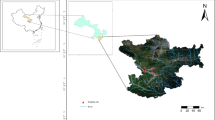Abstract
Vegetation plays in an important role in the amount of surface runoff or infiltration after a rainfall event, specifically on slopes. High infiltration or seepage reduce shearing resistance of soil through the reduction in matric suction of partially saturated slopes, ultimately causing slope instability. On the other hand, low infiltration increases surface runoff and velocity of surface flow, which ultimately causes soil erosion. In this study, three different slopes were prepared using fine sand, specifically at the same dry density and geometry, but with three different vegetation cover densities. The slopes were instrumented with tensiometers at different depths. The slopes were subjected to a rainfall event with an intensity of 30 mm/h and advancement of the wetting front of the seepage water and soil matric suction were recorded with time duration after the rainfall. The experimental result shows that up to certain threshold vegetation cover density, amount of surface flow increases causing soil erosion. For the vegetation density above that threshold, vegetation covers intercept the rainwater and the intercepted water is gradually passed to ground. Moreover, vegetation cover will ease the flow of surface runoff water. These actions, on the other hand, increase the seepage velocity. As such, less dense vegetation cover triggers more rainfall induced soil erosion and denser vegetation cover increases the instability associated with rotational or translational slides.
Access this chapter
Tax calculation will be finalised at checkout
Purchases are for personal use only
Similar content being viewed by others
References
Ajmera B, Tiwari B (2018) Using excel tools for slope stability analysis. In: Landslide dynamics: ISDR-ICL landslide interactive teaching tools, vol 2, pp 413–420
Piciullo L, Stefano LG, Melillo M, Brunetti MT, Peruccacci S, Guzzetti F, Calvello M (2017) Definition and performance of a threshold-based regional early warning model for rainfall-induced landslides. Landslides 14(3):995–1008
Tiwari B, Ajmera B, Khalid M, Donyanavard S, Chavez R (2018) Influence of slope density on the stability and deformation of clayey slopes. Geotech Spec Publ (ASCE) 297:293–301
Tiwari B, Caballero S (2015) Experimental model of rainfall induced slope failure in compacted clays. Geotech Spec Publ (ASCE) 256:1217–1226
Tiwari B, Lewis A, Ferrar E (2013) Experimental simulation of rainfall and seismic effects to trigger slope failures. Geotech Spec Publ (ASCE) 231(1):448–451
Xue K, Ajmera B, Tiwari B, Hu Y (2016) Effect of long duration rainstorm on stability of red-clay slopes. Int J Geo-Environ Disasters (Springer) 3(12):1–13
Acknowledgements
The author would like to thank California State University Fullerton for providing RSCA intramural funding to conduct this study. This project is a part of IPL Project No. 192. As such, the author would like to thank the International Program on Landslides for endorsing the project. The study would not have been possible without the hard work of CSUF Summer Interns from local high schools. The author appreciates the hard work of high school interns Trinity Patron, Sydney Gavela, Austin Chong, Riley Sanidad, Jeffrey Chan, and Nathan Huynh for preparing the slope models, executing the model experiments, and acquiring the experimental data.
Author information
Authors and Affiliations
Corresponding author
Editor information
Editors and Affiliations
Rights and permissions
Copyright information
© 2021 Springer Nature Switzerland AG
About this chapter
Cite this chapter
Tiwari, B. (2021). Experimental Studies on the Effect of Vegetation Density to Change Underground Seepage Rate and Stability of Slopes. In: Tiwari, B., Sassa, K., Bobrowsky, P.T., Takara, K. (eds) Understanding and Reducing Landslide Disaster Risk. WLF 2020. ICL Contribution to Landslide Disaster Risk Reduction. Springer, Cham. https://doi.org/10.1007/978-3-030-60706-7_12
Download citation
DOI: https://doi.org/10.1007/978-3-030-60706-7_12
Published:
Publisher Name: Springer, Cham
Print ISBN: 978-3-030-60705-0
Online ISBN: 978-3-030-60706-7
eBook Packages: Earth and Environmental ScienceEarth and Environmental Science (R0)




